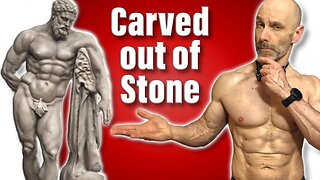Premium Only Content

Do this to find the right number of sets per week for muscle Growth (The Bottom Line)
Choosing the right number of sets per muscle group to achieve maximum muscle growth is a very individual thing. What’s right for you may not be best for me, and it changes over time.
To illustrate, Steve Reeves, an iconic pre-golden era bodybuilder, is well known for doing 9 sets per body part 3 times a week, totalling 27 sets a week! But he didn’t start there, nor does he recommend it for beginners.
In a beginner workout, he suggests only 2 sets per body part each training session totalling 6 sets a week. He had a progression when it came to sets. So how do we go from 2 sets to 27? And does current research even support 27 sets per body part?
More importantly, how do we apply this to ourselves, so we’re training with the optimum amount of sets? In this video, we’re going to answer all these questions. Including a little-known study that establishes how many sets we should add based on our training history to achieve maximum new muscle growth.
If you are interested in losing body fat and adding muscle, please email me at [email protected] for information on my personal training services.
Here is the link to FortisFight https://www.fortisfight.com/product-category/men/ and use my affiliate discount code FITAND50 at checkout for 15% off you next purchase on all of their apparel.
If you would like a set of Torrobands for yourself, here is my affiliate link so you can receive 50% off on your purchase https://sale.torroband.com/?affId=555B3E5D
Check your testosterone levels from home. Just click this link http://trylgc.com/laurence and receive 30% off with code: LAURENCE30 I receive commissions on referrals to LetsGetChecked. I only recommend services I know and trust.
My Affiliate link to Lebert for their Equalizer bars and more; https://lebertfitness.com/?ref=FitAnd50 and use the discount code FITAND50 you will receive 20% off your purchase
Facebook; https://www.facebook.com/Fit-and-50-5...
My Amazon page link; https://www.amazon.com/shop/fitand50
For an overview, let's look at a systematic review on training volume published this year in February. It looked at 7 studies where the participants had at least one year of training experience.
They were broken into one of three groups, under 12 weekly sets, 12 to 20, and over 20. These were hard sets with the test subjects training to failure in all the studies except for one where they trained within 2 repetitions from failure.
The cool thing about this review is it’s the first time there’s been enough information to look at set ranges over 12.
A previous meta-analysis released in 2016 looked at 3 lower set groups, with one being under 5 sets a week, another 5 to 9 and finally 10 or more sets.
This was a more inclusive analysis as it had studies with both new and experienced lifters. It found a dose-response to the number of sets done. Meaning the more sets you do per week, the more muscle growth you’ll experience, at least up to 10 sets.
The new research found an upper limit where we can no longer build muscle faster by adding more sets. Stating the limit was between 12 to 20 sets. Kind of a big range, but this is where individualizing the number of sets comes in.
Most of us have full-time jobs, and our training is done on top of this, leaving us with much less time for recovery.
The bottom line is the maximum amount of volume you can do and fully recover from is what will give you the most muscle growth.
If we’re not completely recovering from our current level of training, it makes no sense to increase our training volume by adding another set. We may need to look at other factors, such as sleep and nutrition.
Now, if we feel fresh and ready for our next workout, then we need to look at the intensity of our training. Are we training close to failure on all are working sets? If not, we should increase the intensity first.
To determine how much volume to add, we’ll look at individualizing how many sets a person is currently doing.
They did this by having the participants train one leg with 22 sets a week and the other with 20% more training volume than they previously had been doing. They did leg presses and extensions.
Half the test subjects were doing between 30 to 120% more volume on the 22-set leg, and yet they had greater muscle growth on the leg than that was only training with 20% more work, indicating that a rapid increase in training volume doesn’t bring about a rapid increase in muscle growth.
The number of sets we should be doing in our programs should be increased gradually, just like the amount of weight or the number of reps we’re doing.
-
 4:47
4:47
Fit and 50
2 years ago $0.04 earnedThe Best Way to Choose Exercises for Muscle Growth (Greek god Physique)
6692 -
 LIVE
LIVE
TimcastIRL
5 hours agoTrump Calls For NUCLEAR OPTION, END Filibuster Over Food Stamp Crisis | Timcast IRL
17,489 watching -

Sarah Westall
3 hours agoBig Banks Caught Rigging Market, IMF tells World to “Buckle Up” w/ Andy Schectman
2.5K -
 1:21:41
1:21:41
Glenn Greenwald
5 hours agoGlenn Takes Your Questions: On the Argentina Bailout, Money in Politics, and More | SYSTEM UPDATE #541
51.6K26 -
 LIVE
LIVE
Barry Cunningham
2 hours agoPRESIDENT TRUMP TO USE NUCLEAR OPTION? FOOD STAMPS END! | SHUTDOWN DAY 31
1,531 watching -
 1:06:56
1:06:56
BonginoReport
10 hours agoThe Battle Between Good & Evil w/ Demonologist Rick Hansen - Hayley Caronia (Ep.168)
77.8K24 -
 1:12:57
1:12:57
Kim Iversen
5 hours agoBill Gates Suddenly Says “Don’t Worry About Climate Change”?
73.2K44 -
 1:05:12
1:05:12
Michael Franzese
5 hours agoI Waited 50 Years to Tell You What Happened on Halloween 1975
29.3K9 -
 1:07:15
1:07:15
Candace Show Podcast
5 hours agoINFILTRATION: Charlie Kirk Was Being Tracked For Years. | Candace Ep 256
71.7K240 -
 LIVE
LIVE
Rallied
4 hours ago $1.80 earnedWarzone Solo Challenges then RedSec Domination
176 watching